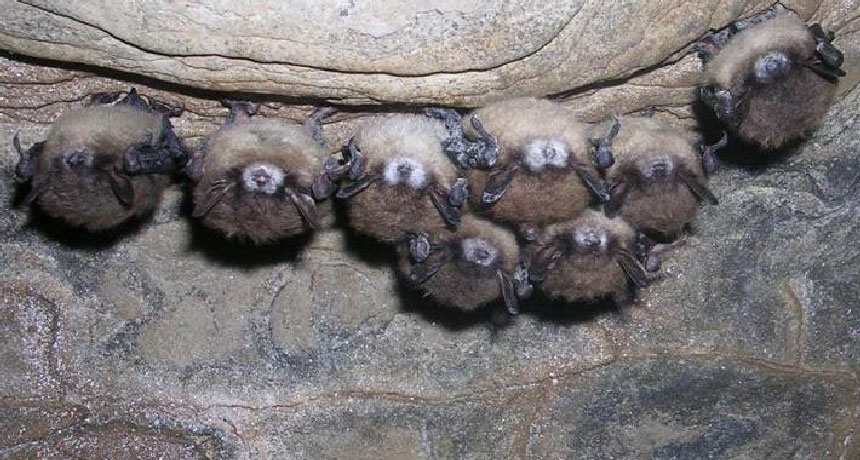
HIBERNATION HANG Hibernating bats in North America have been severely hit by white nose syndrome. New vaccines could improve their odds.
Nancy Heaslip, USGS
- More than 2 years ago
Oral vaccines could give wild bats a better chance at surviving white nose syndrome, the fungal disease that has ravaged bat colonies in North America. In lab tests conducted on captured little brown bats, vaccination led to fewer infected bats developing lesions and more of the bats surviving, researchers report May 1 in Scientific Reports.
White nose syndrome, caused by the fungus Pseudogymnoascus destructans, has killed around 7 million bats in the United States since 2006. In some regions, the disease cut some bat colonies by 75 percent. The white fuzz grows across bats’ skin when the animals hibernate, eventually making them wake up, fly around and waste energy needed to survive winter (SN Online: 1/29/16).
“It’s just devastating to some bat populations,” says veterinarian Elizabeth Falendysz at the U.S. Geological Survey National Wildlife Health Center in Madison, Wis.
Falendysz and colleagues made two vaccines against the fungus by implanting raccoon poxviruses with DNA instructions for making one of two fungal proteins, in order to trick the bats’ immune system into recognizing and fighting the fungus. (Vaccines that helped in rabies eradication efforts and in fighting plague in prairie dogs rely on the same mechanism.)
Wild little brown bats (Myotis lucifugus) were vaccinated before being exposed to the fungus. Of 10 bats given a combination of both vaccines, only one developed lesions within the experiment’s 100-day hibernation period. Because little brown bats don’t do well in captivity, the team struggled with dwindling sample sizes, so it was hard to compare these numbers to other individual treatments. But 14 of the other 23 bats, or 61 percent, that didn’t get this vaccine combo developed lesions.
In a second trial aimed at confirming the results, researchers vaccinated bats both orally and by injection. After 126 days, about 88 percent of bats that received oral versions of both vaccines survived the effects of the fungus, compared with 30 percent of unvaccinated bats (and 80 percent of bats vaccinated by injection). Bats that survived the experiments lost an average of about 34 percent of their body weight, while bats that died had lost about 55 percent. Researchers suspect that slowing the fungus growth or reducing the intensity of infections may have helped vaccinated bats sleep more peacefully and maintain more of their weight and energy.
The team has since combined DNA for both proteins into a single vaccine and hopes to add more proteins for an even stronger jolt to the immune system. “Mortality rates are extremely high for some species that get white nose syndrome, so even modest gains in immunity and survival could make a big difference,” says Winifred Frick, a biologist at the University of California, Santa Cruz.
Researchers have also looked at using antifungal compounds from plants and bacteria to control the fungus, but haven’t deployed them in the field over concerns about possibly harming cave ecosystems.
Falendysz says the team hopes to develop a vaccine spray, which bats could lick from their fur as they groom themselves and spread as they nuzzle other bats — a strategy that’s worked with a rabies vaccine in lab tests on big brown bats. Reaching a large enough number of some wild bat species will require creativity, Frick says, but “there are regions and species where this will be achievable.”





